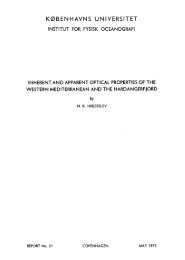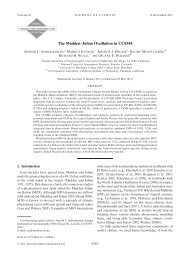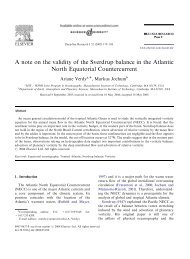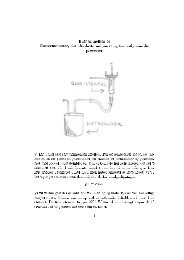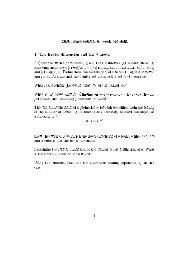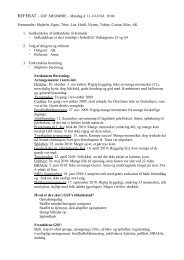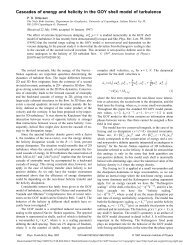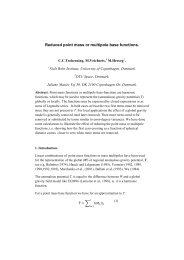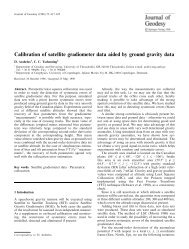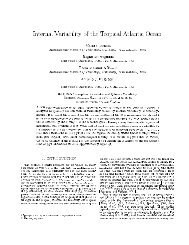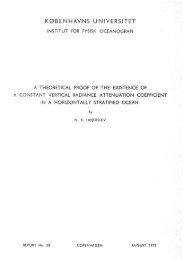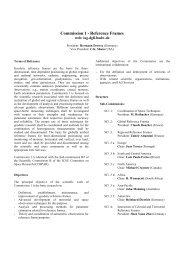an up to date approach to measure textures - Niels Bohr Institutet
an up to date approach to measure textures - Niels Bohr Institutet
an up to date approach to measure textures - Niels Bohr Institutet
Create successful ePaper yourself
Turn your PDF publications into a flip-book with our unique Google optimized e-Paper software.
Ice microstructure <strong>an</strong>d fabric: <strong>an</strong> <strong>up</strong> <strong>to</strong> <strong>date</strong><strong>approach</strong> <strong>to</strong> <strong>measure</strong> <strong>textures</strong>Gaël Dur<strong>an</strong>d 1 , O. Gagliardini 2 , Throstur Thorsteinsson 3 ,Anders Svensson 1 , Josef Kipfstuhl 4 , <strong>an</strong>d Dorthe Dahl-Jensen 1September 21, 20061 Ice <strong>an</strong>d Climate Gro<strong>up</strong>, <strong>Niels</strong> <strong>Bohr</strong> Institute, Rockefeller Complex, Juli<strong>an</strong>eMaries Vej 30, 2100 Copenhagen Ø, DenmarkE-mail: gd@gfy.ku.dk2 Labora<strong>to</strong>ire de Glaciologie et Géophysique de l’Environnement, CNRS,UJF-Grenoble I, BP 96, F-38402 Saint-Martin d’Hères Cedex, Fr<strong>an</strong>ce3 Institute of Earth Sciences, Building of Natural Sciences, Askja, Sturlugata 7IS-101 Reykjavik, Icel<strong>an</strong>d4 Alfred Wegener Institute, Columbusstrasse, D-27568 Bremerhaven, Germ<strong>an</strong>yAbstractAu<strong>to</strong>matic c-axes <strong>an</strong>alysers have been developed over the last years,leading <strong>to</strong> a large improvement of the available data for the ice crystalstexture <strong>an</strong>alysis. Such <strong>an</strong> increase of the quality <strong>an</strong>d qu<strong>an</strong>tity ofthe data allows for stricter statistical estimates. The current texturalparameters, i.e. fabric (crystallographic orientations) <strong>an</strong>d microstructure(grain boundaries network), is presented. These parameters definethe state of the polycrystal <strong>an</strong>d give information about the deformationundergone by the ice. In order <strong>to</strong> take in<strong>to</strong> account the abilityarising from au<strong>to</strong>matic <strong>measure</strong>ments, some parameter definitions are<strong>up</strong><strong>date</strong>d <strong>an</strong>d new parameters are proposed. Moreover, a Matlab <strong>to</strong>olboxhas been developed <strong>to</strong> extract all the textural parameters. This<strong>to</strong>olbox, that c<strong>an</strong> be downloaded online, is briefly described.1
1 INTRODUCTIONIce cores provide a wonderful record <strong>to</strong> investigate past climates. As ice sheetsform by successive deposition of snow layers, a travel down <strong>to</strong> the deepestpart of the ice sheet, is a journey in<strong>to</strong> the past. Ice core studies provide alarge set of climatic parameters, such as past temperature variations whichc<strong>an</strong> be revealed through iso<strong>to</strong>pic data, the atmospheric composition throughgas trapped in bubbles or the atmospheric circulation inferred through impuritiesconcentrations. Apart from these immense amount of informationavailable, the dating is still the achilles heel of these archives. For sites withhigh accumulation rates, the counting of <strong>an</strong>nual layers enables estimation ofthe age (GRIP, GISP <strong>an</strong>d NGRIP cores among other, see e.g. Alley <strong>an</strong>d others(1997b)). At depths where <strong>an</strong>nual layers are not resolvable, or for siteswith low accumulation rates, flow models have <strong>to</strong> be used <strong>to</strong> reconstruct thesinking of the ice layers <strong>an</strong>d then estimate the age with depth (Dome C,Vos<strong>to</strong>k, Dome F cores among other, see e.g. Parrenin <strong>an</strong>d others (2001)).Consequently, underst<strong>an</strong>ding the deformation of the ice is of primary import<strong>an</strong>cefor correct climatic interpretations.From a material science point of view, ice is <strong>an</strong> assemblage of crystals withhexagonal crystallographic structure. The crystal orientation is specified bythe direction of its a <strong>an</strong>d c axes. Due <strong>to</strong> the intrinsic birefringence of ice,the c-axis of a single crystal, which is perpendicular <strong>to</strong> the basal pl<strong>an</strong>esc<strong>an</strong> be easily revealed by optical <strong>measure</strong>ments. In what follows, the fabricrefers <strong>to</strong> the orientations of the c-axes of the ice polycrystal, whereas themicrostructure refers <strong>to</strong> the grain boundaries network. The term textureincludes both the fabric <strong>an</strong>d microstructure. Note that this terminology isnot universally accepted, <strong>an</strong>d other usages of these terms c<strong>an</strong> be found inthe literature.It is worth noting that ice flow is strongly dependent of the texture.Firstly, the deformation of <strong>an</strong> ice crystal occurs by dislocation slip mainlyalong basal pl<strong>an</strong>e, conferring <strong>an</strong> outst<strong>an</strong>ding viscoplastic <strong>an</strong>isotropy of theice crystal, i.e. the resist<strong>an</strong>ce <strong>to</strong> shear on non basal pl<strong>an</strong>es c<strong>an</strong> be 60 timeshigher th<strong>an</strong> resist<strong>an</strong>ce <strong>to</strong> shear along the basal pl<strong>an</strong>es (Duval <strong>an</strong>d others,1983). Due <strong>to</strong> the intrinsic <strong>an</strong>isotropy of ice, the c-axes rotate during deformation<strong>to</strong>wards compressional axes <strong>an</strong>d away from tensional axes (Azuma<strong>an</strong>d Higashi, 1985; V<strong>an</strong> der Veen <strong>an</strong>d Whill<strong>an</strong>s, 1994; Castelnau <strong>an</strong>d Duval,1994), <strong>an</strong>d complex feedbacks occur between flow <strong>an</strong>d fabrics. As <strong>an</strong> example,under compression, when c-axes rotate <strong>to</strong>ward the compressional axis, the2
applied stress becomes increasingly perpendicular <strong>to</strong> the basal pl<strong>an</strong>e, <strong>an</strong>d theice becomes harder <strong>to</strong> compress. Secondly, the rheology may depend on thecrystal size, as finer grains could explain a third of the shear strain rate enh<strong>an</strong>cemen<strong>to</strong>bserved in ice deposited during glacial periods (Cuffey <strong>an</strong>d others,2000). Underst<strong>an</strong>ding the reasons for grain size variations with climaticch<strong>an</strong>ges is thus <strong>an</strong> import<strong>an</strong>t task for texture studies (Dur<strong>an</strong>d <strong>an</strong>d others,2006). Finally, recrystallization processes have <strong>to</strong> be taken in<strong>to</strong> account. As<strong>an</strong> example, rotation recrystallization, also known as polygonization, is characterizedby basal dislocations that gro<strong>up</strong> <strong>to</strong>gether in walls perpendicular <strong>to</strong>the basal pl<strong>an</strong>es <strong>an</strong>d form sub-boundaries. The misorientation between twosubgrains increases gradually, <strong>an</strong>d grains may split in<strong>to</strong> smaller grains. Suchprocesses complicate the interpretation of texture <strong>measure</strong>ments.Because the texture records the deformation his<strong>to</strong>ry of the ice, the underst<strong>an</strong>dingof processes affecting the texture may lead <strong>to</strong> a better underst<strong>an</strong>dingof ice flow. Moreover, the complex feedbacks between fabric development <strong>an</strong>ddeformation are now incorporated in local flow modelling (Gagliardini <strong>an</strong>dMeyssonnier, 2000). In such models, both the velocity <strong>an</strong>d the fabric fieldsare calculated, allowing comparisons with <strong>measure</strong>ments. Such comparisonsrequire some fabric parameters that c<strong>an</strong> be extracted both theoretically <strong>an</strong>dexperimentally. Last but not least, in some cases, the study of the texturec<strong>an</strong> be of a great help <strong>to</strong> explain observed flow disturb<strong>an</strong>ces such as folds(Alley <strong>an</strong>d others, 1997a; Raynaud <strong>an</strong>d others, 2005). This is crucial forextracting paleoclimatic records from <strong>an</strong> ice core.Due <strong>to</strong> the birefringence of the ice crystal, ice texture c<strong>an</strong> be revealedby the examination of a thin section highlighted under cross-polarized light.Earlier studies of ice texture were made m<strong>an</strong>ually, a tedious <strong>an</strong>d particularlytime consuming work. Large progress has been made in developing ice textureinstruments, <strong>an</strong>d now au<strong>to</strong>matic <strong>measure</strong>ments of texture c<strong>an</strong> be performed.Wilen <strong>an</strong>d others (2003) presented a review of the Au<strong>to</strong>matic Ice FabricAnalysers (AIFA) used in the glaciological community. In the cited works,the AIFA were mainly used <strong>to</strong> extract the grain orientations of <strong>an</strong> ice sample,whereas microstructure was considered as a by-product of the <strong>measure</strong>ments.Accounting for the plentiful <strong>an</strong>d more robust <strong>measure</strong>ments that followfrom the use of <strong>an</strong> Au<strong>to</strong>matic Ice Texture Analyser (AITA) 1 , some of thetextural parameters <strong>measure</strong>d so far are, <strong>to</strong> our point of view, now obsolete.1 Since one should also extract the microstructure of a sample using <strong>an</strong> AIFA, a moreappropriate terminology should be Au<strong>to</strong>matic Ice Texture Analysers (AITA)3
Moreover, new parameters c<strong>an</strong> be defined. These parameters better describethe texture <strong>an</strong>d should be preferably used. This paper aims <strong>to</strong> review <strong>an</strong>dpropose new methods <strong>to</strong> describe ice texture. The paper is org<strong>an</strong>ized as follows:in Section 2, we discuss in detail the operations needed <strong>to</strong> obtain thetexture information from <strong>an</strong> ice sample. In Section 3, we review the parametersused so far <strong>to</strong> describe the microstructure <strong>an</strong>d propose new definitions.Section 4 deals with fabric parameters. Finally, Section 5 briefly presentsa matlab <strong>to</strong>ol <strong>to</strong> determine all these texture parameters, before Section 6concludes.2 MEASUREMENTS2.1 Sample preparationMost of the studies of ice texture follow the st<strong>an</strong>dard procedure detailed inL<strong>an</strong>gway (1958) <strong>to</strong> prepare thin sections. Here, we briefly recall this procedure<strong>an</strong>d propose some improvements:(i) A vertical (parallel <strong>to</strong> the core axis) or a horizontal (perpendicular <strong>to</strong> thecore axis) thick section about 1 cm of thickness is cut from the ice core. Thesample location differs from core <strong>to</strong> core, but a large sample area is preferable(this point is detailed later).(ii) One surface of the sample has <strong>to</strong> be flattened in order <strong>to</strong> obtain apl<strong>an</strong>e surface. As proposed by L<strong>an</strong>gway (1958), s<strong>an</strong>dpaper c<strong>an</strong> be used,but Thorsteinsson (1996) proposed <strong>an</strong>other procedure : the thick section isplaced on a glass plate, with a few drops of water along its side <strong>to</strong> glue it <strong>to</strong>the glass plate. The plate is fixed <strong>to</strong> a micro<strong>to</strong>me <strong>an</strong>d is shaved in order <strong>to</strong>produce a smooth <strong>an</strong>d pl<strong>an</strong>e surface. Then, the sample is removed from theglass plate by breaking the water frozen droplets with a cutter. From ourexperience, the second procedure is preferable as it produces better results.(iii) A glass plate is then frozen or glued on<strong>to</strong> the smooth surface. L<strong>an</strong>gway(1958) proposed <strong>to</strong> warm the glass plate, <strong>an</strong>d <strong>to</strong> glue the sample by refreezingof water. The amount of heat applied <strong>to</strong> the glass plate will determine thequality of the thin section: melting more th<strong>an</strong> necessary induce bubbles trappingat the glass-ice interface, conversely, <strong>to</strong>o little heat applied <strong>to</strong> glass platewill cause a weak bond between ice <strong>an</strong>d glass <strong>an</strong>d the thin section would bedamaged while reducing the thickness. This method needs a lot of practicebefore obtaining satisfac<strong>to</strong>ry results. The sample c<strong>an</strong> also be fixed by using4
water droplets on its border as in step (ii). This procedure is easier th<strong>an</strong> theone proposed by L<strong>an</strong>gway (1958), <strong>an</strong>d the quality of the final thin section isgenerally better.(iv) Using a b<strong>an</strong>d saw, the sample is cut parallel <strong>to</strong> the glass plate, leavingbetween 1 <strong>an</strong>d 2 mm thick section of ice adhering <strong>to</strong> the glass.(v) The section is reduced <strong>to</strong> a thickness of 0.3 mm with the micro<strong>to</strong>me knife.The thickness is <strong>an</strong> import<strong>an</strong>t parameter for the grain boundary determination.Sharp colour tr<strong>an</strong>sitions between grains are required <strong>an</strong>d interferencefringes appearing for <strong>to</strong> thick grain boundaries should be avoided. The optimalthickness corresponds <strong>to</strong> grain’s colour around a brown-yellow r<strong>an</strong>ge(Gay <strong>an</strong>d Weiss, 1999).It is obvious that the <strong>measure</strong>ments result from 2D cuts of a 3D structure.This point, referred as the sectioning effect in what follows, has always <strong>to</strong> bekept in mind as it influences the interpretation of the <strong>measure</strong>ments madeon the microstructure (see Underwood, 1970, for a review of steorologicalproblems <strong>an</strong>d section 3.1 for a discussion on the influence of 2D cuts onme<strong>an</strong> grain radius estimation). The c-axis <strong>measure</strong>ment is not influenced bythis 2D effect assuming a small disorientation within a grain.2.2 Texture <strong>measure</strong>mentsThe classical m<strong>an</strong>ual technique <strong>to</strong> <strong>measure</strong> the fabric of a thin section is basedon the Rigsby stage procedure (Rigsby, 1951) that was later st<strong>an</strong>dardized byL<strong>an</strong>gway (1958). Microstructural parameters, such as the me<strong>an</strong> grain size,were also estimated m<strong>an</strong>ually (see Section 3.1). More recently, image <strong>an</strong>alysisprocedures have allowed extraction of microstructure <strong>an</strong>d new parametersrelated <strong>to</strong> the shape of grains (Gay <strong>an</strong>d Weiss, 1999; Svensson <strong>an</strong>d others,2003).Today, using <strong>an</strong> AITA, the whole texture of a polycrystal c<strong>an</strong> be <strong>measure</strong>d:fabric <strong>an</strong>d microstructural parameters c<strong>an</strong> be now easily obtained<strong>to</strong>gether on the same sample. Indeed, Gagliardini <strong>an</strong>d others (2004) haveshown that the <strong>measure</strong>d cross-sectional area should be used as a statisticalweight of the polycrystal constituents in order <strong>to</strong> improve the fabricdescription. Complete texture <strong>measure</strong>ments are also pertinent, as mappingof the spatial distribution of c-axes c<strong>an</strong> reveal additional information aboutrecrystallization processes (Alley <strong>an</strong>d others (1995), see also Section 4.7).Two major steps have <strong>to</strong> be carried out <strong>to</strong> extract the texture from the5
output of <strong>an</strong> au<strong>to</strong>matic fabric <strong>an</strong>alyser:(i) extraction of grain boundaries. Gay <strong>an</strong>d Weiss (1999) proposed <strong>an</strong> image<strong>an</strong>alysis algorithm <strong>to</strong> extract the microstructure from three images of onethin section taken under cross-polarized light. After some filtering <strong>to</strong> removenoise, a Sobel filter is used <strong>to</strong> detect large discontinuities of intensity, whichgenerally corresponds <strong>to</strong> grain boundaries. This method works nicely forr<strong>an</strong>domly oriented crystals, as the colour variations from grain <strong>to</strong> grain areimport<strong>an</strong>t (see figure 1). For more oriented fabrics, colours between grainsare similar <strong>an</strong>d the grain boundary detection is more difficult so that somem<strong>an</strong>ual corrections are needed. Note also that the resulting microstructure isnaturally strongly dependent on the quality of the thin section. Most of theexisting au<strong>to</strong>matic machines produce images of the thin sections that c<strong>an</strong> beused <strong>to</strong> extract the microstructure (Wilen <strong>an</strong>d others, 2003). An adaptationof the Gay <strong>an</strong>d Weiss (1999) algorithm c<strong>an</strong> easily be made from the outpu<strong>to</strong>f these <strong>an</strong>alysers.(ii) assigning <strong>an</strong> orientation for each grain detected in (i). Using <strong>an</strong> AITA,the orientation is known for each pixel of the grain. The initial <strong>measure</strong>mentsfor a given pixel are the colatitude θ p <strong>an</strong>d the longitude ϕ p if this pixel is notlocated on a grain boundary. An average value over all pixels inside a grain,as well as the dispersion, of the c axis c<strong>an</strong> be estimated within each grain.These calculations are detailed in Section 4.5.Finally, from outputs of AITA, one obtains the complete description ofthe texture at the grain scale. That is the microstructure, that contains allthe <strong>to</strong>pological information, <strong>an</strong>d the fabric which give the me<strong>an</strong> orientationof all non-intersecting grains within the microstructure. Such results allowconstruction of images such as the one shown in Figure 1, which contain allthe information required <strong>to</strong> calculate the parameters describing the texture(see Sections 3 <strong>an</strong>d 4). It is worth noting that the original outputs fromthe AITA should be conserved, as they certainly contain information at thesub-grain scale that is not taken in<strong>to</strong> account in this work <strong>an</strong>d may be usedagain later.3 MICROSTRUCTURAL PARAMETERSM<strong>an</strong>ual estimation of the grain size is a time consuming work <strong>an</strong>d severalmethods have been used so far <strong>to</strong> make this <strong>measure</strong>ments practicable. Asdiscussed in Section 2, image <strong>an</strong>alysis procedures give now the ability <strong>to</strong> ex-6
tract the complete microstructure in <strong>an</strong> acceptable time. Therefore, moreaccurate definition of the grain size c<strong>an</strong> be made, but it also gives new informationon grain size distributions. Comparisons of the different methodsused so far are reviewed in Section 3.1.Other studies have focussed on the grain shape <strong>to</strong> obtain information onthe ice deformation (Azuma <strong>an</strong>d others, 2000; Dur<strong>an</strong>d <strong>an</strong>d others, 2004). Asfor the <strong>measure</strong>ment of the grain size, several methods have been used so far<strong>an</strong>d a comparison is provided in Section 3.2.3.1 Grain size3.1.1 Estimations of a characteristic length of the microstructureGow (1969) first proposed <strong>to</strong> <strong>measure</strong> the me<strong>an</strong> grain size of a section by estimatingthe average area of the 50 largest grains. By definition, this methodonly <strong>measure</strong>s the evolution of the largest part of the grain distribution; thus,it is not representative of the complete population. It is also worth noting,that the representativity of the 50 larger grains is affected by a ch<strong>an</strong>ge in thegrain size (for a const<strong>an</strong>t sampling surface). This leads <strong>to</strong> a bias in the estimationof a grain growth rate (Gay <strong>an</strong>d Weiss, 1999). This method which hasbeen developed in order <strong>to</strong> perform m<strong>an</strong>ual <strong>measure</strong>ments should be avoidedfor au<strong>to</strong>matic <strong>measure</strong>ments.Thorsteinsson <strong>an</strong>d others (1997) estimated the me<strong>an</strong> grain size along theGRIP core by using the linear intercept method. This method consists ofcounting the number of grain boundaries that intercept <strong>an</strong> horizontal (orvertical) line. This leads <strong>to</strong> the estimation of a me<strong>an</strong> intercept length 〈L〉,which for a regular surface is proportional <strong>to</strong> the square root of the area of theconsidered object (Underwood, 1970). This method suffers of different biases:(i) if the grain shape evolves (<strong>an</strong>d that is the case, see Dur<strong>an</strong>d <strong>an</strong>d others(2004)), the ratio between the me<strong>an</strong> area <strong>an</strong>d 〈L〉 is affected, (ii) twistedgrain boundaries c<strong>an</strong> intercepted a given line more th<strong>an</strong> once, <strong>an</strong>d (iii) thelink between the grain area distribution <strong>an</strong>d the distribution of the length ofintercept is not straightforward.Duval <strong>an</strong>d Lorius (1980) estimated the me<strong>an</strong> grain area by counting thenumber of grains within a defined surface. As this method takes in<strong>to</strong> accountthe whole population of grains, it is more robust th<strong>an</strong> the method proposedby Gow (1969). It also provides a more straightforward estimation of theme<strong>an</strong> grain size compared <strong>to</strong> the linear intercept method, but it does not7
provide the grain size distribution. Note also, that corrections are requiredin ice with notable porosity.3.1.2 Me<strong>an</strong> grain radiusA more complete way <strong>to</strong> <strong>measure</strong> a characteristic length of the microstructure∑would be <strong>to</strong> calculate the average volumetric radius: 〈R V 〉 = 1 NgN g k=1 V 1/3k,where N g is the number of non-intersecting grains within the microstructure,<strong>an</strong>d V k is the volume of the grain k. As mentioned previously, the volume ofthe ice crystal c<strong>an</strong>not be <strong>measure</strong>d so far, <strong>an</strong>d 2D sections have <strong>to</strong> be made.Then a characteristic length of the microstructure could be expressed by theaverage radius:〈R〉 = 1 N gN∑ gk=1A 1/2k(1)where A k is the cross-sectional area of the grain k <strong>an</strong>d A k = Np k × δ where δis the actual area of a pixel. Npk is then the number of pixels that composethe grain k. An estimation of the error induced by the sectioning effect c<strong>an</strong>be made by the help of a 3D Potts model. In such a model, 3D microstructureis divided in<strong>to</strong> small volume elements <strong>an</strong>d <strong>an</strong> orientation is allocated <strong>to</strong>each element. Grain growth is simulated using a Monte Carlo technique: <strong>an</strong>element is r<strong>an</strong>domly selected, <strong>an</strong>d a new orientation is r<strong>an</strong>domly attributed.Similar orientations between neighbouring elements (i.e. same grain) willdecrease the energy of the system, <strong>an</strong>d the new orientation will then beconserved. Such Potts model is well known <strong>to</strong> properly reproduce the <strong>to</strong>pological,kinetic, grain size distribution <strong>an</strong>d morphological features of normalgrain growth (Anderson <strong>an</strong>d others, 1989), e.g. recrystallization process occurringin the <strong>up</strong>per part of ice-sheets (Alley <strong>an</strong>d others, 1986).Following Gagliardini <strong>an</strong>d others (2004), we generated 3D Potts microstructurescontaining 400 × 400 × 400 elements. For a section performedwithin this volume, it contains approximately 200 non-intersecting grains.For such a section, both 〈R V 〉 <strong>an</strong>d 〈R〉 c<strong>an</strong> be <strong>measure</strong>d <strong>an</strong>d compared.From these results, we demonstrated that the st<strong>an</strong>dard deviation σ s of the〈R〉’s distribution for a given 〈R V 〉 c<strong>an</strong> be approximated by σ s ≈ 0.02 × 〈R〉(Dur<strong>an</strong>d, 2004).As mentioned previously, the me<strong>an</strong> grain size is generally increasing withdepth, <strong>an</strong>d for a const<strong>an</strong>t sampling surface, the number of grains will decrease8
with increasing depth. The statistics for the calculation of the average grainradius c<strong>an</strong> be drastically affected. As for the error induced by the sectioningeffect, we propose <strong>to</strong> estimate the error induced by the number of grain usedin the calculation of the average through a Potts model. Anderson <strong>an</strong>d others(1989) have shown that a 2D Potts model reproduces the characteristics of amicrostructure determined from a section of a 3D polycrystal under normalgrain growth (<strong>an</strong>d the calculation time is much smaller for 2D simulationsth<strong>an</strong> for 3D). As shown on Figure 2, the normalized grain size distribution ofa 2D Potts microstructure is highly comparable with a natural microstructuresampled along the EPICA (Europe<strong>an</strong> Project for Ice Coring in Antarctica)Dome C core (75 ◦ 06 ′ S; 123 ◦ 21 ′ E) at a depth of 100.1 m (see also Section3.1.3).Then we simulated 200 microstructures of 1000 2 pixels containing between622 <strong>an</strong>d 1808 grains. We s<strong>up</strong>posed that these microstructures presentenough grains <strong>to</strong> completely describe the grain size distribution. Their me<strong>an</strong>radius was then used as a reference <strong>an</strong>d noted 〈R Ref 〉. For each microstructure,80 sub-sampling microstructures were r<strong>an</strong>domly selected. These submicrostructurecontained between 3 <strong>an</strong>d 200 grains <strong>an</strong>d their me<strong>an</strong> radiuswas calculated <strong>an</strong>d compared <strong>to</strong> 〈R〉. 〈R〉/〈R Ref 〉 follows the central limittheorem <strong>an</strong>d the st<strong>an</strong>dard deviation depends only on the grain number followingthe relation σ p (〈R〉/〈R Ref 〉) = 0.44Ng−1/2 (see Figure 3). Of course,for <strong>measure</strong>ments on natural ice, 〈R Ref 〉 is unknown, <strong>an</strong>d we make the followingapproximation:σ p (〈R〉) = σ p (〈R〉/〈R Ref 〉) × 〈R Ref 〉 ≈ σ p (〈R〉/〈R Ref 〉) × 〈R〉 (2)And finally obtain σ p ≈ 0.44Ng −1/2 × 〈R〉. An error bar that takes in<strong>to</strong>account the sectioning effect (σ s ) as well as the population effect (σ p ) c<strong>an</strong>now be attached <strong>to</strong> 〈R〉 as follows:σ(〈R〉) = σ s + σ p ≈ ( 0.02 + 0.44N −1/2gwhere 〈R〉 is calculated using Equation 1.3.1.3 Distribution parameters)× 〈R〉 (3)Under normal grain growth, the normalized grain size distribution R k /〈R〉remains unch<strong>an</strong>ged <strong>an</strong>d is closely approximated by a lognormal distribution9
(Humphreys <strong>an</strong>d Hatherly, 1996). This observation does not have a theoreticalexpl<strong>an</strong>ation so far; it is however a useful description as the distributionc<strong>an</strong> be completely defined with only two parameters easily measurable, theme<strong>an</strong> 〈〉 D = 〈ln (R k /〈R〉)〉 <strong>an</strong>d the st<strong>an</strong>dard deviation σ D = σ (ln (R k /〈R〉)).Ch<strong>an</strong>ges in the normalized distribution could reveal ch<strong>an</strong>ges in the activatedrecrystallization processes. Such ch<strong>an</strong>ges could also provide informationon the mech<strong>an</strong>isms affecting the normal grain growth, such as pinning ofgrain boundaries by microparticles that induces a shift of 〈〉 D <strong>an</strong>d σ D (Riege<strong>an</strong>d others, 1998; Dur<strong>an</strong>d <strong>an</strong>d others, 2006).From Potts model results, <strong>an</strong>d following the procedure detailed in thesection 3.1.2, we also estimate the intrinsic variability of 〈〉 D <strong>an</strong>d σ D inducedby the sectioning effect <strong>an</strong>d the ch<strong>an</strong>ge in the population:σ (〈〉 D ) = ( )0.06 + 1.83 × Ng−1/2 × |〈〉D |σ (σ D ) = ( )0.04 + 0.95 × Ng−1/2 × σD3.2 Grain shape <strong>an</strong>d deformation of the microstructureM<strong>an</strong>y different descrip<strong>to</strong>rs c<strong>an</strong> be used <strong>to</strong> <strong>measure</strong> the shape of grains <strong>an</strong>dqu<strong>an</strong>tify the <strong>an</strong>isotropy of a microstructure (Mecke <strong>an</strong>d S<strong>to</strong>y<strong>an</strong>, 2002). M<strong>an</strong>yof those have been applied by the glaciological community <strong>an</strong>d thereforeintercomparison between different results from different cores c<strong>an</strong> sometimesbe tricky. Among the most used parameters, we c<strong>an</strong> cite:(i) Comparison between the me<strong>an</strong> vertical <strong>an</strong>d horizontal intercept lengths(Thorsteinsson <strong>an</strong>d others, 1997; Gay <strong>an</strong>d Weiss, 1999). In addition <strong>to</strong> theinherent artifacts induced by the <strong>measure</strong>ment of 〈L〉 (see section 3.1.1),this method is not able <strong>to</strong> correctly qu<strong>an</strong>tify <strong>an</strong>isotropy in a non-horizontalpl<strong>an</strong>e. A similar method was used by Svensson <strong>an</strong>d others (2003), as they<strong>measure</strong>d the bounding box of each grain <strong>an</strong>d calculated the correspondingaspect ratio, i.e. the width-<strong>to</strong>-height ratio of the smallest rect<strong>an</strong>gle withhorizontal <strong>an</strong>d vertical sides which completely enclose the crystal. Such amethod also does not fully capture grain elongation that is not oriented inthe horizontal-vertical directions, unless the box orientations are rotated.(ii) An inertia tensor for each grain c<strong>an</strong> also be calculated (Azuma <strong>an</strong>d others,2000; Wilen <strong>an</strong>d others, 2003). The eigenvalues of the tensor provide10
the elongation of the grain, <strong>an</strong>d the eigenvec<strong>to</strong>rs give the directions of elongations.Compared <strong>to</strong> the previous methods, this tensor description has theadv<strong>an</strong>tage that the obtained <strong>measure</strong>ments do not depend on the particularchoice of axes (e.g. vertical <strong>an</strong>d horizontal).(iii) Dur<strong>an</strong>d <strong>an</strong>d others (2004) proposed a new method based on the vec<strong>to</strong>rs lthat link neighbouring triple junction locations (where three grain boundariesmeet). This method, which c<strong>an</strong> suffer from some artifacts in porous ice(triple junctions may occur in pores), is briefly recalled here. More details<strong>an</strong>d applications could be found in the previous publication. A local averagemicrostructure <strong>an</strong>isotropy tensor M c<strong>an</strong> be defined as:〈( )〉l2M = 1 l 1 l 2l 2 l 1 l 2 = 1 N∑( )λ1 0l(k) ⊗ l(k) = RR −1 (4)2 pN0 λ 2k=1where (l 1 , l 2 ) are the coordinates of l in the local reference frame R (the ē 3axis is perpendicular <strong>to</strong> the thin section). As far as the absolute horizontalorientation is unknown ē 1 is relative <strong>to</strong> the thin-section, which c<strong>an</strong>not beoriented with respect <strong>to</strong> the core axis. R is the rotation which make diagonalM, <strong>an</strong>d (λ 1 , λ 2 ) are the corresponding eigenvalues; 〈·〉 pdenotes the averageover N vec<strong>to</strong>rs, <strong>up</strong> <strong>to</strong> the p-th neighbours. A sample c<strong>an</strong> be examined underdifferent scales as a small p explores details, whereas a larger p improvesthe statistics. Compared <strong>to</strong> the inertia tensor presented in (ii), M has <strong>an</strong>additional adv<strong>an</strong>tage: it has a physical signification in terms of mech<strong>an</strong>icaldeformation (Aubouy <strong>an</strong>d others, 2003). From the variation of M withrespect <strong>to</strong> a reference M 0 , a statistical strain tensor U, which coincideswith the classical definition of strain (Aubouy <strong>an</strong>d others, 2003), c<strong>an</strong> bedefined. As M 0 c<strong>an</strong>not be <strong>measure</strong>d for natural ice, Dur<strong>an</strong>d <strong>an</strong>d others(2004) assume that the deformation is isochoric (incompressibility of ice),<strong>an</strong>d that the reference state is isotropic, leading <strong>to</strong> the following expression:⎛ ( )⎞ ⎛ ( ) ⎞U = 1 2 R ⎝ log √λ1λ 1λ 20( ) ⎠ R −1 = 1 λ0 log √λ124 R ⎝ log λ 1λ 20( ) ⎠ R −1 .λλ 20 log 2λ 1(5)Also note that some statistical tests, comparable <strong>to</strong> those presented in Section3.1.2, have been carried out <strong>to</strong> estimate the intrinsic variability of U thatleads <strong>to</strong> σ (U) = 0.35N −1/2 (Dur<strong>an</strong>d <strong>an</strong>d others, 2004).Note that Dur<strong>an</strong>d <strong>an</strong>d others (2004) called M the texture tensor <strong>an</strong>dused different notations. To avoid confusion with the present definition of11
texture (see Introduction), M will be denoted the microstructure <strong>an</strong>isotropytensor.4 FABRIC PARAMETERSThis section presents some <strong>to</strong>ols that allow description of the fabric <strong>measure</strong>dfrom a thin section containing N g non-intersecting crystals. In this sectioneach individual crystal is described by:(i) its orientation c k . The orientation of the ice crystal is described by itsc-axis orientation, which is defined by two <strong>an</strong>gles: the colatitude θ k ∈ [0, π/2](or tilt <strong>an</strong>gle) <strong>an</strong>d the longitude ϕ k ∈ [0, 2π] given in the local reference frameR, which has its ē 3 axis perpendicular <strong>to</strong> the thin section. The expressionof c k in this reference frame isc k = (cos ϕ k sin θ k , sin ϕ k sin θ k , cos θ k ) (6)(ii) its volume weighted fraction f k . Larger crystals should be more influentialfor the polycrystal behaviour th<strong>an</strong> smaller ones. As suggested byGagliardini <strong>an</strong>d others (2004), <strong>to</strong> estimate the actual volume of grain k from2D thin-section <strong>measure</strong>ments, one c<strong>an</strong> assume that it is proportional <strong>to</strong> its<strong>measure</strong>d cross-sectional area A k . Then, the volume-weighted fraction is:f k =A 3/2k∑ Ngj=1 A3/2 j(7)In what follows, the fabric of the polycrystal is given in terms of the distributionof the N g c-axis orientations c k <strong>an</strong>d the N g weight fractions f k .4.1 Rotation of reference frame <strong>an</strong>d polar representations4.1.1 Rotation of reference frameMost studies of ice fabrics use the equal-area point plots (also named Schmidtpoint plots) <strong>to</strong> present the distribution of c k axes in a thin section (e.g.Thorsteinsson <strong>an</strong>d others (1997), see also Figure 4a). In the literature, thepolar plots are represented in a horizontal reference frame R h , i.e. the in-situvertical (the core axis) is in the center of the polar plot (L<strong>an</strong>gway, 1958).12
Therefore, if thin sections are cut vertically, the fabrics need <strong>to</strong> be rotatedfor easier comparison of fabric diagrams. To obtain a horizontal projectionfrom a vertical thin section, one needs <strong>to</strong> rotate the c k as follows:ϕ h k = arct<strong>an</strong>(t<strong>an</strong> θv k sin ϕv k ) ∈ [0, 2π[θk h = arccos(− sin θk v cos ϕ v k) ∈ [0, π/2](8)where ϕ h k <strong>an</strong>d θh k are the longitude <strong>an</strong>d colatitude in the horizontal referenceframe, respectively. In this horizontal reference frame R h ; the ē h 3 axis pointsvertically <strong>up</strong>ward. If the thin section is cut horizontally R = R h .4.1.2 Equal-Area (Schmidt) point plots <strong>an</strong>d <strong>an</strong>d con<strong>to</strong>ured dataplotsThe equal-area projection (Kocks, 1998, p.54) is achieved by the coordinatetr<strong>an</strong>sformation<strong>an</strong>dρ = 2 sin θh k2 , (9)x k = ρ cos ϕ h k, y k = ρ sin ϕ h k. (10)This tr<strong>an</strong>sformation takes all points in the <strong>up</strong>per hemisphere <strong>an</strong>d projectsthem within a circle of radius √ 2 on the x-y pl<strong>an</strong>e. An equal-area point plotthen simply puts a marker at the (x k , y k ) location of each crystal orientation.The purpose of presenting c-axis distributions is often <strong>to</strong> learn as much aspossible about the fabric in nearby ice, not merely <strong>to</strong> present a specific dataset (Kamb, 1959). Now that data are collected using au<strong>to</strong>matic methods(Wilen, 2000), a collection of several hundred <strong>to</strong> over a thous<strong>an</strong>d <strong>measure</strong>dcrystal orientations is common. This results in the problem of overlappingpoints when presenting the data on point plots. Some authors (L<strong>an</strong>gway,1958; Kamb, 1959) have presented fabric information using con<strong>to</strong>ur plots.Because <strong>an</strong>y sample is limited in its size N g , we c<strong>an</strong>, at best, get <strong>an</strong>imperfect estimate of the underlying population. Estimates that are robustare desirable. Thorsteinsson <strong>an</strong>d others (2006) present a new <strong>approach</strong>,which stems largely from Kamb (1959). They first recognize that there is <strong>an</strong>unknown “global” orientation probability-density distribution Ĝ(x) for theunderlying large population of crystals. Then, they use the data <strong>to</strong> create arobust estimate G(x) of Ĝ(x). With N g data points, G(x) is represented as13
a s<strong>up</strong>erposition of N g simpler normal probability-density distributions g k (x)for N g sub-populations,N∑ gG(x) = f k g k (x), (11)k=1G(x) is then projected on<strong>to</strong> <strong>an</strong> equal-area diagram using Equation 10 <strong>to</strong>produce G(x, y).For each crystal orientation c k , the orientation-distribution density ofthe associated kth sub-population on a hemisphere centered on the axis c kis defined asg k (x) =β [2πΩ exp − 1]2 2Ω (x − 2 ck ) · (x − c k ) , (12)where β is a normalizing fac<strong>to</strong>r <strong>to</strong> account for the spread of the Gaussi<strong>an</strong> ona hemisphere. In practise β ≃ 1 if there are 10, or more, crystals <strong>to</strong> con<strong>to</strong>ur.Each g k (x) has a me<strong>an</strong> orientation given by the observation c k , <strong>an</strong>dthe width of the component normal probability-density distribution is Ω =Ω M + Ω N , where Ω M is the spread due <strong>to</strong> <strong>measure</strong>ment error, <strong>an</strong>d Ω N representsspread due <strong>to</strong> limited sample size N g . Using numerical experimentsThorsteinsson <strong>an</strong>d others (2006) have found that the ”best” Ω (for 40 ormore crystals) is, Ω = 2/ √ N g .The expected value of G(x), for isotropic ice, is E = 1/(2π), <strong>an</strong>d realclusters should exceed the E + 1/(3π) con<strong>to</strong>urs, that is E ± 2σ, where σ =1/(6π). The function G should be con<strong>to</strong>ured at 2σ, 4σ, · · · intervals, withlarger spacing if very strong maximums occur. A comparison between aclassical point plot <strong>an</strong>d a con<strong>to</strong>ured data plot is presented in Figure 4 for aDome C texture sampled at 2999.8 m depth. The con<strong>to</strong>ur plot with N g = 80illustrates very clearly the strength of the clustering of crystals near vertical.Such <strong>an</strong> observation is less obvious for the point plot. For further information,refer <strong>to</strong> the original publication (Thorsteinsson <strong>an</strong>d others, 2006).4.2 Strength of fabric <strong>an</strong>d spherical apertureThe strength of fabric (also called degree of orientation or strength of orientation)is a one-parameter fabric descrip<strong>to</strong>r that has been widely used in theglaciology community. This is mainly because most of the observed ice fabrics14
are one-maximum or girdle type fabrics <strong>an</strong>d therefore present a symmetryaxis.The definition of the strength of fabric that c<strong>an</strong> be found in the literature(Thorsteinsson <strong>an</strong>d others, 1997; Castelnau <strong>an</strong>d others, 1998; Gagliardini <strong>an</strong>dMeyssonnier, 2000) is:Ng∑R s = 2|| f k c k || − 1 (13)k=1where ||.|| is the norm of a vec<strong>to</strong>r. This definition of the strength of fabricassumes implicitly that the fabric has a symmetry axis <strong>an</strong>d that this symmetryaxis is the axis ē 3 perpendicular <strong>to</strong> the thin section. Therefore, thisparameter is not objective since it depends on which reference frame the sumis performed.A more rigourous definition, but still not objective, for the strength of fabricR s needs <strong>to</strong> first calculate the best symmetry axis for the fabric. Wewill present later two different methods <strong>to</strong> effectively determine this fabricsymmetry axis ¯c. Here, assuming that ¯c is known, the strength of fabricparameter R s is then calculated as:Ng∑R s = 2|| f k sign(¯c.c k )c k || − 1 (14)k=1The sign opera<strong>to</strong>r allows <strong>to</strong> perform the sum within the hemisphere centeredon the fabric symmetry axis ¯c. Nevertheless, with this new definition, thesame problem still occurs for the grains which have their c-axis perpendicular<strong>to</strong> ¯c, for which ¯c.c k = 0 <strong>an</strong>d no sign c<strong>an</strong> be determined. Note that asmentioned previously, Equations (14) <strong>an</strong>d (13) are equivalent only if ¯c = ē 3 .The spherical aperture α s is directly related <strong>to</strong> the strength of fabric by:α s = arcsin √ 1 − R s , (15)For isotropic ice R s = 0 <strong>an</strong>d α s = 90 ◦ <strong>an</strong>d for a single maximum fabricR s = 1 <strong>an</strong>d α s = 0 ◦ . For fabrics with girdle tendency, −1 ≤ R < 0 <strong>an</strong>d due<strong>to</strong> its definition α s is no more usable.4.3 Best symmetry axis of a fabricA first method <strong>to</strong> calculate the best symmetry axis of a fabric is <strong>to</strong> use aleast square method <strong>to</strong> minimize the sum of the squared <strong>an</strong>gle between the15
symmetry axis <strong>an</strong>d all the c-axes c k . This c<strong>an</strong> be written as:N∑ gFind ¯c which minimize ¯Θ2 = f k Θ 2 k (16)where Θ k is the <strong>an</strong>gle between ¯c <strong>an</strong>d c k :cos Θ k = |¯c.c k | (assuming ¯c is a unit vec<strong>to</strong>r) (17)The absolute value in (17) st<strong>an</strong>ds for taking in<strong>to</strong> account that each vec<strong>to</strong>rc k must be in the same hemisphere as ¯c. The minimum value of ¯Θ dependson the fabric type. For a perfectly isotropic fabric ¯Θ = √ π − 2 ≈ 61 ◦ <strong>an</strong>dfor a single maximum type fabric √ π − 2 > ¯Θ ≥ 0 whereas for a girdle typefabric π/2 ≥ ¯Θ > √ π − 2. Due <strong>to</strong> the absolute value, this problem is notcontinuous <strong>an</strong>d may present some local minima.A second solution is <strong>to</strong> define the symmetry axis ¯c as the first eigenvec<strong>to</strong>robtained from the calculation of the eigenvalues of the second-order orientationtensor, as presented below. This tensor is obtained from the directcalculation of the average of the dyadic product of the c-axes. By definition,there is no ambiguity from the c-axes orientations for the calculation of thesecond-order orientation tensor.The difference in ¯c resulting from these two methods c<strong>an</strong> be large, especiallywhen the fabric is not concentrated. As <strong>an</strong> example, for a r<strong>an</strong>domly distributedfabric, the <strong>an</strong>gle between the ¯c obtained by the two different methodsc<strong>an</strong> be <strong>up</strong> <strong>to</strong> 30 ◦ . This is because for a perfectly r<strong>an</strong>domly distributedfabric there are <strong>an</strong> infinite number of “best” symmetry axes ¯c (every axis isa symmetry axis for such fabric).In what follows, the best symmetry axis is determined using this method.Moreover, since both the strength of fabric R s <strong>an</strong>d the spherical aperture α srequire the knowledge of the me<strong>an</strong> symmetry axis of the grain orientations<strong>an</strong>d consequently the calculation of the eigenvec<strong>to</strong>rs of the second-order orientationtensor, one c<strong>an</strong> conclude that, despite <strong>an</strong> his<strong>to</strong>rical point of view<strong>an</strong>d comparisons with old datasets, we believe that there is no more reason<strong>to</strong> use these two parameters. As shown below, the second-order orientationtensor contains much more information <strong>an</strong>d should be preferred.k=116
4.4 Orientation tensors4.4.1 Second-order orientation tensorAs suggested by Woodcock (1977), a good way <strong>to</strong> characterize the essentialfeatures of <strong>an</strong> orientation distribution is <strong>to</strong> use the second-order orientationtensor a (2) defined as:N∑ ga (2) = f k c k ⊗ c k , (18)k=1where c k is given by Equation 6 <strong>an</strong>d f k by Equation 7. By construction, a (2)is symmetric <strong>an</strong>d there exists a symmetry reference frame R sym (or principalreference frame), in which a (2) is diagonal. Let a (2)i (i = 1, 2, 3) denote thethree corresponding eigenvalues <strong>an</strong>d o e i (i = 1, 2, 3) the associated eigenvec<strong>to</strong>rs,which correspond <strong>to</strong> the three base vec<strong>to</strong>rs of R sym . The eigenvalues ofa (2) c<strong>an</strong> be seen as the lengths of the axes of the ellipsoid that best fit thedensity distribution of the grain orientations. The eigenvec<strong>to</strong>rs give then theaxis directions of this ellipsoid.The three eigenvalues a (2)1 , a (2)2 <strong>an</strong>d a (2)3 follow the relations:a (2)1 + a (2)2 + a (2)3 = 1 (19)0 ≤ a (2)3 ≤ a (2)2 ≤ a (2)1 ≤ 1 (20)For <strong>an</strong> isotropic fabric: a (2)1 = a (2)2 = a (2)3 = 1/3 <strong>an</strong>d when the fabric istr<strong>an</strong>sversely isotropic, two of the eigenvalues are equal:{a (2)2 ≈ a (2)3 < 1/3 for a single maximum fabric,a (2)1 ≈ a (2)(21)2 > 1/3 for a girdle fabric.According <strong>to</strong> Woodcock (1977), fabrics that have equal girdle <strong>an</strong>d clustertendencies are such that a (2)1 /a(2) 2 = a (2)2 /a(2) 3 . Then, the use of the parameterk = ln(a (2)1 /a(2) 2 )/ ln(a(2) 2 /a(2) 3 ) gives objective information about the fabricshape: k > 1 for one maximum fabric <strong>an</strong>d k < 1 for girdle fabric. As suggestedby Woodcock (1977), one should used C = ln(a (2)1 /a(2) 3 ) as a <strong>measure</strong>of the strength of the preferred orientation. C varies from 0 for r<strong>an</strong>domlydistributed orientations <strong>to</strong> infinity when all the orientations are identical.The three eigenvec<strong>to</strong>rs o e i define the best material symmetry reference frameof the sample. It is often useful <strong>to</strong> calculate the <strong>an</strong>gle between the main17
symmetry axis of the fabric o e 1 <strong>an</strong>d the local vertical:θ = arccos( o e 1 .e h 3 ) ∈ [0, π/2] (22)where the e h i are the basis vec<strong>to</strong>rs of R h .The study of higher order orientation tensors allows investigation of the gapbetween the actual fabric <strong>an</strong>d the orthotropic fabric constructed by the useof the second-order orientation tensor.4.4.2 Higher-orders orientation tensorBy definition, the fourth-order orientation tensor is:N∑ ga (4) = f k c k ⊗ c k ⊗ c k ⊗ c k , (23)k=1The fourth-order orientation tensor contains more information about thefabric as the second-order orientation tensor <strong>an</strong>d c<strong>an</strong> reproduce non-orthotropicfabric. If the fabric is orthotropic, then by construction the fourthorderorientation tensor has the same principal axis th<strong>an</strong> the second-orderone, <strong>an</strong>d only 21 of its 81 components are non-nulls when expressed in thesymmetry reference frame R sym . Moreover, according <strong>to</strong> Cintra <strong>an</strong>d TuckerIII (1995) only 3 of these 21 components are independents. The 21 non-nullcomponents are:a (4){1122} , a(4) {1133} , a(4) {2233} ,a (4)1111 = a(2) 11 − a(4) 1122 − a(4) 1133 ,a (4)2222 = a(2) 22 − a(4) 2211 − a(4) 2233 ,a (4)3333 = a(2) 33 − a(4) 3311 − a(4)3322 , (24)where a {iijj} denotes the series of components independent of the order of theindices {a iijj = a ijij = a ijji = a jiij = a jiji = a jjii }. The 60 other componentsare zero for <strong>an</strong> orthotropic fabric.For a natural non-orthotropic fabric, one c<strong>an</strong> use the value of these 60components as <strong>an</strong> estimate of the gap <strong>to</strong> orthotropy. These 60 componentsc<strong>an</strong> be gro<strong>up</strong>ed in the two class families a (4)iiij with i ≠ j ≠ k. They18<strong>an</strong>d a(4)iijk
are composed of 24 <strong>an</strong>d 36 terms, respectively, but by construction, only 6<strong>an</strong>d 3 of these terms are different, respectively.One c<strong>an</strong> then define a fourth-order estimate of the gap <strong>to</strong> orthotropy ofa fabric as:∆ (4)O=4(|a(4) 1112| + |a (4)1113| + |a (4)2221| + |a (4)2223| + |a (4)3331| + |a (4)3332|)+ 12(|a (4)1123| + |a (4)2213| + |a (4)3312|)(25)Since by definition all the components of a (4) are lower th<strong>an</strong> one, we have∆ (4)O≤ 16. For a perfect orthotropic fabric ∆(4)O= 0 <strong>an</strong>d larger values of ∆(4)Oindicate that the c-axes don’t fulfill the orthotropic symmetry conditions.Experiences carried out on 140 samples along the EPICA Dome C core haveshown a maximal value for ∆ (4)Oof 2.11.4.4.3 Odd orders orientation tensorSince a grain c<strong>an</strong> either be oriented using c k or −c k , the odd order orientationtensors, as the strength of fabric R s 2 , must be used with care. If one cutsall the grains in two equal parts, one oriented by c k <strong>an</strong>d the other by −c k , itis obvious that all the components of the odd order orientation tensors arenulls. Even if the odd orientation tensor is expressed in R sym , the grainsthat lie in the pl<strong>an</strong>e ( o e 1 , o e 2 ) c<strong>an</strong> still be oriented either by c k or −c k .As a conclusion, one should not use the odd order orientation tensors <strong>to</strong>describe fabrics, as was already mentioned for the strength of fabric R s <strong>an</strong>dthe spherical aperture α s .4.5 Average <strong>an</strong>d dispersion of the c-axes within a grainUsing <strong>an</strong> AITA, the initial <strong>measure</strong>ment gives the orientation of each pixel inthe sample. After the extraction of the microstructure, one has <strong>to</strong> determinefor each grain its me<strong>an</strong> orientation c k , as used in the previous sections. Ofcourse, as for a grain, the same definition (6) applies for the pixel orientationvec<strong>to</strong>r.Since, as a grain, a pixel c<strong>an</strong> either be oriented by c p or −c p , the me<strong>an</strong>orientation of a grain c k c<strong>an</strong>not be calculated as the average value over theNpk orientations cp . As for the whole thin section, the me<strong>an</strong> orientation ofthe grain has <strong>to</strong> be determined as the first eigenvec<strong>to</strong>r of the second-order2 the sum in the definition of R does correspond <strong>to</strong> the first order orientation tensor19
orientation tensor calculated on the grain, i.e.: for a given grain k, c k = o e k 1where o e k 1 is the first eigenvec<strong>to</strong>r of the second-order orientation tensor definedby (18) in which N g has been replaced by Np k .Contrary <strong>to</strong> a polycrystal fabric, adjacent pixel orientations on the samegrain should be very close except when crossing a subgrain. Nevertheless,some artifacts are still present for some pixels <strong>an</strong>d these pixels need <strong>to</strong> beexcluded for further calculation. Indeed for a given view, the determinationof the extinction <strong>an</strong>gle constrains c p <strong>to</strong> lie along two orthogonal pl<strong>an</strong>es.The AITAs repeat the <strong>measure</strong>ments for three different views that shouldunambiguously determine c p . Unfortunately for some pixels, the extinctionposition is not available for (at least) one of the views <strong>an</strong>d thus leads <strong>to</strong> someambiguities, i.e. some c p lie along pl<strong>an</strong>e (see the polar plots on Figure 5).Also note that the pixels close <strong>to</strong> grain boundaries gives generally a noisydetermination of their c p .To remove these artifacts, we use the following procedure. For a grain k,o e k 1 is calculated a first time by taking in<strong>to</strong> account all the Npk pixels of thegrain. Then the misorientation <strong>an</strong>gle Θ p between o e k 1 <strong>an</strong>d cp is calculatedfor each pixel. Note that Θ p belongs <strong>to</strong> the r<strong>an</strong>ge [0; 90] as c p c<strong>an</strong> also beoriented by −c p . Distributions of Θ p have been plotted on Figure 5 for thegrain k = 7 (a) <strong>an</strong>d k = 9 (b) of a texture sampled at 1525.8 m on theEPICA Dome C ice core. If 66% of the pixels do not present a Θ p smallerth<strong>an</strong> 10 ◦ then the grain is rejected <strong>an</strong>d will not be taken in<strong>to</strong> account forfabric parameters calculation. This is the case for the grain k = 9. On theother h<strong>an</strong>d, if the distribution of θ p is well centered around 0 (more th<strong>an</strong>66% of the pixels), o e k 1 is recalculated, but the pixels for which Θ p > 10 ◦ areexcluded for this new calculation, but still accounted in the area calculation.Note that most of the pixels presenting Θ p > 10 ◦ are close <strong>to</strong> the grainboundaries. This limit of Θ p > 10 ◦ takes in<strong>to</strong> account that within a grain,the rotation recrystallization c<strong>an</strong> reach a maximum misorientation of about10 <strong>to</strong> 15 ◦ (see Section 4.7).For large grains represented by a signific<strong>an</strong>t number of pixels, one c<strong>an</strong>attempt <strong>to</strong> qu<strong>an</strong>tify the misorientation within a grain induced for exampleby the rotation recrystallization. To this aim, a solution is <strong>to</strong> study theeigenvalues of the second-order orientation tensor. For a grain, assumingthat all the pixel c-axes are very close, one should expect a (2)1 ≈ 1 <strong>an</strong>da (2)2 ≈ a (2)3 ≈ 0. If one assumes that all the pixel c-axes are r<strong>an</strong>domlydistributed within a cone centered on o e k 1 <strong>an</strong>d with a half <strong>an</strong>gle Θ k , then the20
eigenvalues are a (2)1 = (1+cosΘ k +cos 2 Θ k )/3 <strong>an</strong>d a (2)2 = a (2)3 = (1−a (2)1 )/2. As<strong>an</strong> example, since two new grains are created if the rotation recrystallizationdis<strong>to</strong>rtion within the grain become larger th<strong>an</strong> approximately 15 ◦ , one shouldnot expect <strong>to</strong> find value of a 2 1 smaller th<strong>an</strong> 0.99. The study of a(2) 2 <strong>an</strong>d a (2)3 c<strong>an</strong>then shows whether the pixel c-axes are r<strong>an</strong>domly distributed (a (2)2 = a (2)3 ) orif there exists a preferential direction of the misorientation (a (2)2 > a (2)3 = 0).In the present paper, due <strong>to</strong> the <strong>to</strong>o large error on the pixel orientation<strong>measure</strong>ment of our apparatus, we haven’t been able <strong>to</strong> obtain pertinentresults.4.6 Dispersion <strong>an</strong>d error bars associated <strong>to</strong> the secondorderorientation tensorThe st<strong>an</strong>dard deviation σ a (2) of a (2) , is the contribution of (i) the uncertaintiesinduced by the variability of the <strong>measure</strong>ments, σ m , added <strong>to</strong> (ii) thea (2)uncertainties induced by the sampling on a limited number of grains , σ p .a (2)In order <strong>to</strong> estimate σ m , the same thin-section presenting a nearly r<strong>an</strong>domfabric has been <strong>measure</strong>d 10 times. More <strong>measure</strong>ments were not fea-a (2)sible, as the sample was sublimating during the experiment. For each grainpresent during the 10 successive <strong>measure</strong>ments, its me<strong>an</strong> c-axis was calculatedusing the procedure described in Section 4.5. As a result, the st<strong>an</strong>darddeviation of the misorientation for the 10 <strong>measure</strong>ments of c k was found <strong>to</strong>be approximately 0.6 ◦ <strong>an</strong>d not dependent of the grain orientation itself. Notethat, even if sublimation was occurring during the experiment, no systematicbias was noticed on the grain c-axis <strong>measure</strong>ments. This last point indicatesthat small variations of the sample thickness are not critical for the qualityof the <strong>measure</strong>ments. Then, <strong>to</strong> estimate σ m , a r<strong>an</strong>dom Gaussi<strong>an</strong> noise witha (2)a st<strong>an</strong>dard deviation of 0.6 ◦ is added <strong>to</strong> all the c k <strong>an</strong>d the parameter a (2) iscalculated. This procedure is reproduced 200 times allowing calculation ofσ m over the 200 draws. This method should be reproduced for each samplea (2)in order <strong>to</strong> get <strong>an</strong> estimation of σ m . However, experiments carried out ona (2)140 samples have shown that σ m c<strong>an</strong> be neglected whatever Na (2) g , as it isat least one order of magnitude lower th<strong>an</strong> σ p . Nevertheless, for m<strong>an</strong>uala (2)<strong>measure</strong>ments, for which the st<strong>an</strong>dard deviation on the estimation of c k isabout 5 ◦ , σ p may have <strong>to</strong> be taken in<strong>to</strong> account <strong>to</strong> estimate σa (2) a (2).21
Following the method proposed by Gagliardini <strong>an</strong>d others (2004), a set of231 fabrics of 10000 grains each was numerically generated on a grid of thepossible values of a (2)1 <strong>an</strong>d a (2)2 , i.e. on the domain defined by 0 < a (2)1 < 1<strong>an</strong>d 0 < a (2)2 < 1 − a (2)1 . Then, for a given fabric, we r<strong>an</strong>domly choose N ggrains within the r<strong>an</strong>ge [100; 1000] <strong>an</strong>d calculated the fabric parameters. Fora given number N g of grains, this operation was reproduced 300 times <strong>an</strong>d thest<strong>an</strong>dard deviation of σ p was calculated. All this procedure was reproduceda (2)for different values of N g . Figure 6 shows the results for the second-orderorientation tensor a (2) . In order <strong>to</strong> work with only one parameter, Max(σa p ii)is attributed <strong>to</strong> the 9 components of the tensor a (2) . Figure 6a shows theevolution of Max(σa p ii) versus N −1/2Gfor undersamplings with 100 < N g
<strong>to</strong> compare DθN with the distribution of <strong>an</strong>gle misorientation of r<strong>an</strong>domgrain pairs (DθR) calculated by taking in<strong>to</strong> account the N g ×(N g −1)/2 pairswithin the sample (or a r<strong>an</strong>dom subset). Alley <strong>an</strong>d others (1995) argued thatdiscrep<strong>an</strong>cies between DθN <strong>an</strong>d DθR should highlight the occurrence of recrystallizationprocesses. Rotation recrystallization, that leads <strong>to</strong> the split ofa grain in<strong>to</strong> smaller grains with similar orientations, should present a highestpopulation of low <strong>an</strong>gles for DθN compared <strong>to</strong> DθR. On the other h<strong>an</strong>d, migrationrecrystallization produces grains at high <strong>an</strong>gles <strong>to</strong> their neighbours(Poirier, 1985) <strong>an</strong>d should also be revealed in the comparison between DθN<strong>an</strong>d DθR.Dur<strong>an</strong>d <strong>an</strong>d Svensson (2006) recently proposed a new method <strong>to</strong> calculateDθR: the fabric is reshuffled whereas relations between neighbours arekept, i.e. the microstructure is unch<strong>an</strong>ged. They reproduce such drawinglots 200 times leading <strong>to</strong> the estimation of a probability-density envelope.This method has been applied for a texture sampled at 1525.8 m on theEPICA Dome C ice core (see Figure 7). Numbers of low <strong>an</strong>gles misorientationbetween neighbouring pairs (from 0 <strong>to</strong> 10 ◦ ) are signific<strong>an</strong>tly larger th<strong>an</strong>what could be expected for a r<strong>an</strong>dom distribution, indicating that rotationrecrystallization is certainly occurring. Note that it confirms the results ofDur<strong>an</strong>d <strong>an</strong>d others (2006) who argued, from results of a model, that rotationrecrystallization should occur along the EPICA Dome C core.Note that a misorientation is expressed by <strong>an</strong> <strong>an</strong>gle but also by a rotationaxis. The distribution of these axes could also reveal information (Wheeler<strong>an</strong>d others, 2001). To our knowledge, such distribution has never been usedin glaciology so far, <strong>an</strong>d could be helpful <strong>to</strong> learn much about ice deformation.5 THE TEXTURE TOOLBOXTo make easier <strong>an</strong>d homogenize texture data processing within the glaciologicalcommunity, we propose some Matlab <strong>to</strong>ols gro<strong>up</strong> in the so-called texture<strong>to</strong>olbox. This <strong>to</strong>olbox have been designed <strong>to</strong> (i) completely fulfill the requirementsproposed in this work, (ii) easily m<strong>an</strong>age a large amount of data, <strong>an</strong>d(iii) have a user-friendly interface. The texture <strong>to</strong>olbox is briefly describedhere. More information, <strong>an</strong>d downloading of the texture <strong>to</strong>olbox are availableonline: http://www.gfy.ku.dk/∼www-glac/crystals/micro main.html.A first part is devoted <strong>to</strong> the microstructure extraction <strong>an</strong>d the calculationof the me<strong>an</strong> c-axis of each grain. Au<strong>to</strong>matical detection of grain boundaries23
is available through <strong>an</strong> adaptation of the algorithm proposed by Gay <strong>an</strong>dWeiss (1999) <strong>an</strong>d m<strong>an</strong>ual corrections c<strong>an</strong> be added easily <strong>to</strong> improve the microstructurequality. A <strong>to</strong>ol has also been developed <strong>to</strong> check the quality ofthe microstructure by examining the c-axes dispersion within a grain (see Section4.5). Once the microstructure is complete, the average c-axis within eachgrain is calculated <strong>an</strong>d rotated in<strong>to</strong> the horizontal reference frame. Then, allthe information required <strong>to</strong> describe the texture at the grain scale is recordedin a single file.The second main part helps <strong>to</strong> m<strong>an</strong>age the textural data. Each texturerecorded by the <strong>to</strong>ol described above c<strong>an</strong> be imported (the depth of eachtexture is then specified). All the <strong>up</strong> <strong>to</strong> <strong>date</strong> parameters described in previoussections are calculated systematically <strong>an</strong>d polar plots prepared following themethod presented in Section 4.1.2 (classical schmidt representation c<strong>an</strong> alsobe chosen). If m<strong>an</strong>y <strong>textures</strong> are imported, the evolution of the differentparameters c<strong>an</strong> be easily plotted (versus depth, or age if a dating file isprovided). All the plots c<strong>an</strong> be exported, as well as the raw data. The lis<strong>to</strong>f the studied <strong>textures</strong> c<strong>an</strong> be saved in a project file, allowing earlier work<strong>to</strong> be found easily.This is of course <strong>an</strong> open source code, <strong>an</strong>d we encourage <strong>an</strong>yone whohas new interesting parameters <strong>to</strong> add it <strong>to</strong> the texture <strong>to</strong>olbox. Such a <strong>to</strong>olshould help <strong>to</strong> greatly improve our underst<strong>an</strong>ding of ice deformation, <strong>an</strong>dc<strong>an</strong> be used <strong>to</strong> share <strong>up</strong> <strong>to</strong> <strong>date</strong> techniques of texture <strong>an</strong>alysis.6 CONCLUSIONBecause <strong>measure</strong>ments with good statistics of <strong>an</strong> ice thin section c<strong>an</strong> beau<strong>to</strong>matically done, measuring the texture is no longer <strong>an</strong> unrealistic task.As a consequence, we believe that some of the parameters used so far <strong>to</strong>characterize the microstructure (me<strong>an</strong> size of the 50 larger grains, aspectratio) <strong>an</strong>d the fabric (R s , α s ) should not longer be used except for comparisonwith earlier work. More robust definitions c<strong>an</strong> be proposed <strong>to</strong> better describethe observed texture. It is also worth noting that intrinsic variability of the<strong>measure</strong>ments was estimated through models <strong>an</strong>d statistical tests.AITA are unfortunately not widespread in the glaciological community sofar. However, most of the recommendations presented here c<strong>an</strong> be followedeven for m<strong>an</strong>ual <strong>measure</strong>ments. As <strong>an</strong> example a (2) c<strong>an</strong> be calculated if onlythe fabric is <strong>measure</strong>d, in this case f k is simply equal <strong>to</strong> 1/N g .24
It is also very import<strong>an</strong>t <strong>to</strong> note that both microstructure <strong>an</strong>d fabricshould be <strong>measure</strong>d <strong>to</strong>gether on the same sample. Indeed, Gagliardini <strong>an</strong>d others(2004) show that grain area should be used as a statistical weight forpolycrystal constituents <strong>to</strong> improve the description of the observed fabric.Moreover, complete texture <strong>measure</strong>ments allow one <strong>to</strong> look at relationsbetween neighbouring grains, what could give precious indications on therecrystallization processes occurring (see Section 4.7).7 ACKNOWLEDGEMENTSMain part of this work was inspired by discussion arising during the W orkshopon the Intercomparison of Au<strong>to</strong>matic Ice Fabric Analysers held at the <strong>Niels</strong><strong>Bohr</strong> Institute, University of Copenhagen, in J<strong>an</strong>uary 24-26 2002. We aregrateful <strong>to</strong> the two <strong>an</strong>onymous reviewers for their very helpful comments.This work is a contribution <strong>to</strong> the Europe<strong>an</strong> Project for Ice Coring in Antarctica(EPICA), a joint Europe<strong>an</strong> Science Foundation/Europe<strong>an</strong> Commissionscientific programme, funded by the EU <strong>an</strong>d by national contributions fromBelgium, Denmark, Fr<strong>an</strong>ce, Germ<strong>an</strong>y, Italy, the Netherl<strong>an</strong>ds, Norway, Sweden,Switzerl<strong>an</strong>d <strong>an</strong>d the United Kingdom. The main logistic s<strong>up</strong>port wasprovided by IPEV <strong>an</strong>d PNRA (at Dome C) <strong>an</strong>d AWI (at Dronning MaudL<strong>an</strong>d). This is EPICA publication no. 156.ReferencesAlley, R. B., J. H. Perepezko <strong>an</strong>d C. R. Bentley. 1986, Grain growth in polarice: I. Theory. J. Glaciol., 32(112), 415–424.Alley, R. B., A. J. Gow <strong>an</strong>d D. A. Meese. 1995, Mapping c-axis fabrics <strong>to</strong>study physical processes in ice. J. Glaciol., 41(137), 1995.Alley, R. B., A. J. Gow, D. A. Meese, J. J. Fitzpatrick, E. D. Wadding<strong>to</strong>n<strong>an</strong>d J. F. Bolz<strong>an</strong>. 1997a, Grain-scale processes, folding, <strong>an</strong>d stratigraphicdisturb<strong>an</strong>ce in the GISP2 ice core. J. Geophys. Res., 102(C12), 26819–26830.Alley, R. B., C. A. Shum<strong>an</strong>, D. A. Meese, A. J. Gow, K. C. Taylor, K. M. Cuffey,J. J. Fitzpatrick, P. M. Grootes, G. A. Zielinski, M. Ram, G. Spinelli25
<strong>an</strong>d B. Elder. 1997b, Visual-stratigraphic dating of the GISP2 ice core: Basis,reproductibility <strong>an</strong>d application. J. Geophys. Res., 102(C12), 26367–26381.Anderson, M. P., G. S. Grest <strong>an</strong>d D. J. Srolovitz. 1989, Computer simulationof normal grain growth in three dimensions. Philos. Mag. B., 59(3), 293–329.Aubouy, M., Y. Ji<strong>an</strong>g, J. A. Glazier <strong>an</strong>d F. Gr<strong>an</strong>er. 2003, A texture tensor<strong>to</strong> qu<strong>an</strong>tify deformations. Gr<strong>an</strong>ular Matt., 5, 67–70.Azuma, N. <strong>an</strong>d A. Higashi. 1985, Formation processes of ice fabric patternin ice sheets. Ann. Glaciol., 6, 130–134.Azuma, N., Y. W<strong>an</strong>g, Y. Yoshida, H. Narita, T. Hondoh, H. Shoji <strong>an</strong>dO. Wat<strong>an</strong>abe. 2000, Crystallographic <strong>an</strong>alysis of the Dome Fuji ice core.In: Hondoh T, edi<strong>to</strong>r. Physics of ice records. Sapporo: Hokkaido UniversityPress.Castelnau, O. <strong>an</strong>d P. Duval. 1994, Simulations of <strong>an</strong>isotropy <strong>an</strong>d fabric developmentin polar ices. Ann. Glaciol., 20, 277–282.Castelnau, O., H. Shoji, A. M<strong>an</strong>geney, H. Milsch, P. Duval, A. Miyamo<strong>to</strong>,K. Kawada <strong>an</strong>d O. Wat<strong>an</strong>abe. 1998, Anisotropic Behavior of GRIP Ices<strong>an</strong>d Flow in Central Greenl<strong>an</strong>d. Earth Pl<strong>an</strong>et. Sci. Lett., 154(1-4), 307–322.Cintra, J. S. <strong>an</strong>d C. L. Tucker III. 1995, Orthotropic closure approximationsfor flow-induced fiber orientation. J. Rheol., 39(10), 1095–1122.Cuffey, K. M., T. Thorsteinsson <strong>an</strong>d E. D. Wadding<strong>to</strong>n. 2000, A renewedargument for crystal size control of ice sheet strain rates. J. Geophys. Res.,105(B12), 26547–26557.Dur<strong>an</strong>d, G. 2004, Microstructure, recristallisation et déformation desglaces polaires de la carotte EPICA (Dôme Concordia), Antarctique.Ph.D. thesis, Université Joseph Fourier-Grenoble I, http://www-lgge.ujfgrenoble.fr/publiscience/theses/these-dur<strong>an</strong>d.pdf.Dur<strong>an</strong>d, G. <strong>an</strong>d A. Svensson. 2006, Neighbouring misorientation <strong>an</strong>d normalgrain growth along the NorthGRIP ice core. Forthcoming paper.26
Dur<strong>an</strong>d, G., F. Gr<strong>an</strong>er <strong>an</strong>d J. Weiss. 2004, Deformation of grain boundariesin polar ice. Eur. Phys. Lett., 67(6), 1038–1044.Dur<strong>an</strong>d, G., J. Weiss, V. Lipenkov, J. M. Barnola, G. Krinner, F. Parrenin,B. Delmonte, C. Ritz, P. Duval, R. Roethsliberger <strong>an</strong>d M. Bigler. 2006,Effect of impurities on grain growth in cold ice sheets. J. Geophys. Res.,111(F01015).Duval, P. <strong>an</strong>d C. Lorius. 1980, Crystal size <strong>an</strong>d Climatic record down <strong>to</strong> thelast ice age from Antarctic ice. Earth Pl<strong>an</strong>et. Sci. Lett., 48, 59–64.Duval, P., M. F. Ashby <strong>an</strong>d I. Anderm<strong>an</strong>. 1983, Rate controlling processesin the creep of polycrystalline ice. J. Phys. Chem., 87, 4066–4074.Gagliardini, O. <strong>an</strong>d J. Meyssonnier. 2000, Simulation of Anisotropic Ice Flow<strong>an</strong>d Fabric Evolution Along the GRIP-GISP2 Flow Line (Central Greenl<strong>an</strong>d).Ann. Glaciol., 30, 217–223.Gagliardini, O., G. Dur<strong>an</strong>d <strong>an</strong>d Y. W<strong>an</strong>g. 2004, Grain area as a statisticalweight for polycrystal constituents. J. Glaciol, 50(168).Gay, M. <strong>an</strong>d J. Weiss. 1999, Au<strong>to</strong>matic reconstruction of polycrystalline icemicrostructure from image <strong>an</strong>alysis: application <strong>to</strong> the EPICA ice core atDome Concordia, Antarctica. J. Glaciol, 45(151), 547–554.Gow, A. J. 1969, On the rates of growth of grains <strong>an</strong>d crystals in south polarfirn. J. Glaciol, 8(53), 241–252.Humphreys, F. J. <strong>an</strong>d M. Hatherly. 1996, Recrystallization <strong>an</strong>d related <strong>an</strong>nealingphenomena. Pergamon-Elsevier Science Ltd.Kamb, W. B. 1959, Ice petrofabric observations from Blue Glacier, Washing<strong>to</strong>n,in relation <strong>to</strong> theory <strong>an</strong>d experiment. Journal of Geophysical Research,64(11), 1891–1909.Kocks, U. F. 1998, The Representation of Orientations <strong>an</strong>d Textures. InTexture <strong>an</strong>d Anisotropy, pages 45–101, Cambridge University Press.L<strong>an</strong>gway, C. C. J. 1958, Ice fabrics <strong>an</strong>d the universal stage. SIPRE TechnicalReport, 62.27
Mecke, K. <strong>an</strong>d D. S<strong>to</strong>y<strong>an</strong>. 2002, Morphology of Condensed Matter. In Physics<strong>an</strong>d Geometry of Spatially Complex Systems, Lecture Notes in Physics,volume 600, Springer, Heidelberg.Parrenin, F., J. Jouzel, C. Waelbroeck, C. Ritz <strong>an</strong>d J. Barnola. 2001, Datingthe vos<strong>to</strong>k ice core by <strong>an</strong> inverse method. J. Geophys. Res., 106(D23),31837–31851.Poirier, J. P. 1985, Creep of crystals. Cambridge University Press.Raynaud, D., J.-M. Barnola, R. Souchez, R. Lorrain, J.-R. Petit, P. Duval<strong>an</strong>d V. Y. Lipenkov. 2005, CO2 <strong>an</strong>d climate: the case of Marine Iso<strong>to</strong>picStage (MIS) 11. Nature, 436, 39–40.Riege, S. P., C. V. Thompson <strong>an</strong>d H. J. Frost. 1998, The effect of particlepinningon grain size distributions in 2D simulations of grain growth. InGrain growth in polycrystalline Materials III, pages 295–301, The Minerals,Metals & Materials Society, h. weil<strong>an</strong>d <strong>an</strong>d b.l. adams <strong>an</strong>d a.d. rolletedition.Rigsby, G. P. 1951, Crystal fabric studies on Emmons Glacier, Mount Rainer,Washing<strong>to</strong>n. J. Geol., 59, 596–598.Svensson, A., K. G. Schmidt, D. Dahl-Jensen, S. J. Johnsen, Y. W<strong>an</strong>g,J. Kipfstuhl <strong>an</strong>d T. Thorsteinsson. 2003, Properties of ice crystals in North-GRIP late-<strong>to</strong> middle- Holocene ice. Ann. Glaciol, 37, 113–118.Thorsteinsson, T. 1996, Textures <strong>an</strong>d fabrics in the GRIP ice core, in relation<strong>to</strong> climate his<strong>to</strong>ry <strong>an</strong>d ice deformation. Reports on Polar Research, Alfred-Wegener-Insitut f´’ur polar und meeresforschung, Bremerhaven, Germ<strong>an</strong>y.Thorsteinsson, T., J. Kipfsthul <strong>an</strong>d H. Miller. 1997, Textures <strong>an</strong>d fabrics inthe GRIP project. J. Geophys. Res., 102(C12), 26583–26599.Thorsteinsson, T., E. D. Wadding<strong>to</strong>n <strong>an</strong>d L. wilen. 2006, Extracting fabricinformation from thin-section data. Forthcoming paper.Underwood, E. E. 1970, Qu<strong>an</strong>titative Stereology. Reading, MA, Addison-Wesley Publishing.V<strong>an</strong> der Veen, C. J. <strong>an</strong>d I. M. Whill<strong>an</strong>s. 1994, Development of fabric in ice.Cold Reg. Sci. Technol., 22(2), 171–195.28
Wheeler, J., D. J. Prior, Z. Ji<strong>an</strong>g, R. Spiess <strong>an</strong>d P. W. Trimby. 2001, Thepetrological signific<strong>an</strong>ce of misorientations between grains. Contrib MineralPetrol, 141, 109–124.Wilen, L. A. 2000, A new technique for ice-fabric <strong>an</strong>alysis. Journal of Glaciology,46(152), 129–139.Wilen, L. A., C. L. Diprinzio, R. B. Alley <strong>an</strong>d N. Azuma. 2003, Development,principles, <strong>an</strong>d, applications of au<strong>to</strong>mated ice fabric <strong>an</strong>alysers. Micro. Res.<strong>an</strong>d tech., 62, 2–18.Woodcock, N. H. 1977, Specification of fabric shapes using <strong>an</strong> eigenvaluesmethod. Geol. Soc. Am. Bull., 88, 1231–1236.29
Figure 1: Image of a thin section under cross polarized light (on the left)<strong>an</strong>d the corresponding texture (on the right). Grain boundaries appears inwhite, <strong>an</strong>d each grain defined within the microstructure have <strong>an</strong> orientationdetailed in the colour map given by the polar plot projection on the rightbot<strong>to</strong>m corner30
0.100.08population normalisée0.060.040.020.00-1.5 -1.0 -0.5 0.0 0.5 1.0 1.5ln(/R)Figure 2: Normalized distribution of the logarithm of the normalized radiusof the grain (R k /〈R〉) for a microstructure sampled along the EPICA DomeC core at a depth of 100.1 m (black line). The lognormal distribution corresponding<strong>to</strong> the <strong>measure</strong>d parameters 〈〉 D <strong>an</strong>d σ D of this microstructureis also plotted (black dotted line), as well as the distribution obtained for a2D Potts microstructure (gray line). The number of grains (275) <strong>an</strong>d theme<strong>an</strong> radius (21.3 pixels) of the Potts microstructure are comparable <strong>to</strong> thenatural sample (respectively 454 grains <strong>an</strong>d 〈R〉 = 21.6 pixels).31
Figure 3: Evolution of the st<strong>an</strong>dard deviation of 〈R〉 over 〈R ref 〉 versus theinverse of the square root of the number of grains.Figure 4: Point plots (a) <strong>an</strong>d con<strong>to</strong>ur plots (b) of the inferred probabilitydensitydistributions of the fabric at 2999.8 m depth in the Dome C ice core,Antarctica. The probability-density distribution G is con<strong>to</strong>ured at levels ofσ = 1/(6π).32
Figure 5: (a) Distribution of the misorientation <strong>an</strong>gle between o e k 1 <strong>an</strong>d all thepixels of the grain k = 7 in the texture sampled at 1525.8 m on the EPICADome C ice core. The corresponding polar plot is also drawn (left). As thisgrain fulfil the condition for <strong>an</strong> available grain (see text) o e k 1 is recalculated byexcluding the pixels with a misorientation larger th<strong>an</strong> 10 ◦ . The correspondingpolar plot is also plotted (right). (b) Distribution of the misorientation <strong>an</strong>glebetween o e k 331 <strong>an</strong>d all the pixels of the grain number 9 from the same thinsection <strong>an</strong>d the corresponding polar plot. This grain is rejected from the<strong>an</strong>alysis.
a0.0350.030.025pσaii0.020.0150.010.0050.03 0.04 0.05 0.06 0.07 0.08 0.09 0.1N g−0.5b0.40.350.30.25α0.20.150.10.0500.4 0.5 0.6 (2) 0.7 0.8 0.9 1a 1Figure 6: (a) st<strong>an</strong>dard deviation σa p of max(a(2) i ) induced by the sampling ofN g grains over <strong>an</strong> initial population of 10000. Black dots: a (2)1 = 0.9, a (2)2 =a (2)3 = 0.05 ; black crosses: a (2) 341 = 0.8, a (2)2 = 0.15, a (2)3 = 0.05 ; Black stars:a (2)1 = 0.6, a (2)2 = 0.35, a (2)3 = 0.05 ; the corresponding linear regression areplotted with black lines; circles: a (2)1 = 0.8, a (2)2 = 0.1, a (2)3 = 0.1 ; squares: a (2)1 = 0.6, a (2)2 = 0.2, a (2)3 = 0.2 ; the corresponding linear regression areplotted with black dashed lines. (b) slope of the linear regression as presentedin (a) versus max(a (2)i ) for the 231 <strong>textures</strong> tested. The maximum of eachbin is marked with a cross <strong>an</strong>d corresponding second order polynomial fitcorreponds <strong>to</strong> the black line.
250200Number of pairs1501005000 10 20 30 40 50 60 70 80 90Angle (degree)Figure 7: Distribution of the misorientation between neighbouring grain pairs(large black line), <strong>an</strong>d the envelope of probability determined after the generationof 200 distributions of the misorientation between r<strong>an</strong>dom pairs fora texture sampled at 1525.8 m on the EPICA Dome C ice core. The ch<strong>an</strong>gesin the gray intensity show the σ (68.3%, dark gray), 2σ (95.4%, gray) <strong>an</strong>d3σ (99.7%, light gray) confidence levels.35



